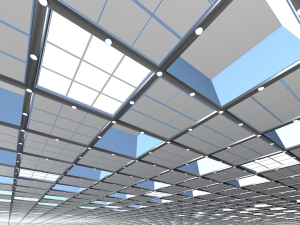How to install a CCTV camera in a ceiling tile?
 With so many offices, warehouses and workshops having suspended ceilings these days, it can be tricky to find a good position for your dome CCTV camera without securing it to a ceiling tile.
With so many offices, warehouses and workshops having suspended ceilings these days, it can be tricky to find a good position for your dome CCTV camera without securing it to a ceiling tile.
Although modern dome cameras are made from high technology yet lightweight materials, they should not be affixed to a ceiling tile without some kind of additional support.
Using a secondary supprt is advisable
Ceiling tiles vary in thickness and density and as they age they can become more brittle and likely to snap. For this reason, even if you are confident in the rigidity of your ceiling tiles, it is preferable to use some sort of secondary support to ensure your camera doesn’t end up getting damaged.
Manufacturers do supply various pieces of kit which will help to tackle this problem. There are a number of adjustable mounting brackets available which have been developed specifically to support dome cameras on suspended ceilings and which are suitable for the smaller and more lightweight cameras.
For heavier cameras there are suspended metal frames available which house the camera and are then suspended from part of the building structure above the ceiling tile and therefore put no weight on the tile at all.
These accessories can, however, be fairly expensive to purchase.
Yes, there are aleternative options
If you are confident to use a few simple tools then there are more inexpensive and convenient options available which will ensure your camera is secure and safe in the ceiling tile.
For smaller and more lightweight cameras, using a plywood or MDF backing can provide enough additional support to the camera and will help to spread the weight of the camera more evenly across the tile.
And here is how to do it…
To fit a camera using this method, take the ceiling tile down and place the plywood or MDF board on the upper side of the tile (i.e. the side you would not see from the inside of the building). Using the base of the camera as a guide, simply drill through the board and the ceiling tile to gain access to the screw holes which secure the camera in place. You will also need to cut access in the centre of the tile and board for the wiring to the junction box.
Heavier cameras may require additional support, as this method still relies upon the ceiling tile taking most of the weight of the camera. You may also want to go a step further if you are concerned about tampering, as using the previous method will still allow the camera to be forcibly taken down if someone is determined enough.
To prevent this, you may want to apply a more secure method
For a more secure method of attachment, use two lengths of wood or metal to brace a support across the frame of the suspended ceiling.
You will need to remove tiles to either side of the tile you plan to fix the camera to in order to secure your bracing bars to the frame of the ceiling. Ideally you would fix your camera to the ceiling tile and bracing bars using the same fundamental method as above, before feeding the bracing bars into place in the frame and securing them using screws or wire ties.
Just a word of warning, though
However you choose to fix your dome camera to the ceiling tiles, be sure to cut the power supply to the junction box before undertaking any wiring work. Observe health and safety rules regarding working with ladders and tools and ensure there is no asbestos in your ceiling tiles before attempting to cut them.
If you are looking for a practical CCTV Installation Course, then we have an offer
F R Joseph regularly runs CCTV Installation Courses. F R Joseph Anton Ltd., however, is not exclusively a training center. We regularly do installation work. Surely, you can learn a lot of practical tricks at our courses. Ready to join? Learn about our CCTV Installation Courses here.
